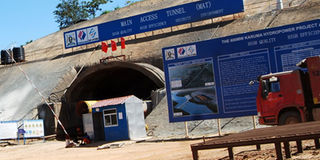Uganda requires more power to meet demand’

Construction works going on at the Karuma Hydro Power Project. The dam is expected to add about 600MW to the national grid. File photo
What you need to know:
Mr Kenyatta said the regional bloc will, in the coming years, encourage member states to invest more in power generation and cross-border inter-connection
Kampala. Uganda must have increased its power generation capacity by 37.7 per cent by 2020 if it is to meet the rapid industrialisation and urbanisation, according to Mr Richard Sezibera, the East African Community (EAC) secretary general.
Mr Sezibera made the remarks at the recent 16th EAC Heads of States summit, adding that member countries including Kenya, Tanzania and Rwanda must grow their generation capacity by 96.4 per cent, 75.3 per cent and 115 per cent respectively to meet projected demand.
East Africa has a combined electricity demand of 5.3 per cent per annum.
The above demand, according to Mr Sezibera, requires all member states to increase generational capacity by 2020.
Uganda currently has installed generational capacity of 852 Mega Watts (MW) but projections demand that the country should have grown its power prospects by over 400 MW.
Energy key to competitiveness
Speaking at the summit, Kenyan President Uhuru Kenyatta said energy is a key factor of competitiveness needed to support regional growth initiatives including urbanisation.
“We have undertaken substantial developments aimed at establishing sufficient, reliable and affordable power supply, which shall ensure that the region is on the right development track,” he said.
The region has in the recent past undertaken ambitious projects which will see Kenya grow its capacity by at least 5,000MW, Tanzania 3,000MW and Rwanda 500MW.
The projects are expected to at least add more 10,000MW on the region’s power grid.
For instance, Uganda is currently working on the Karuma Power Dam where the country expects to generate about 600MW to add to the national grid.
However, a number of plans have been put in place to diversify power generation including hydro, geothermal, wind and natural gas.
The move is likely to be supported by the recent discovery of oil and natural gas in Uganda, Kenya and Tanzania.
Mr Kenyatta said the regional bloc will, in the coming years, encourage member states to invest more in power generation and cross-border inter-connection.
EAC Operating capacities
Uganda: Uganda has installed generation capacity of 852 Megawatts from Nalubaale, Kiira and Bujagali while more generation is expected once construction of Karuma Power Dam is completed.
Kenya: Kenya plans to add 5,000MW to the national grid while Tanzania plans to add 3,000MW and Rwanda 500MW.
Rwanda: In April, the World Bank approved a $100 million loan to partly finance two hydropower plants in Rwanda that will jointly generate 48MW. Currently, the country faces a daily shortage of 20-25MW of power.
Tanzania: Tanzania meanwhile plans to add about 1,800MW of gas-fired electricity to the grid over the next three years.



